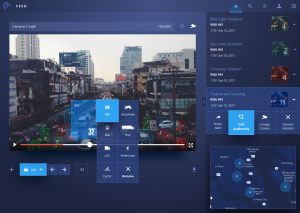By Anthony Fulgoni, Chief Revenue Officer, Calipsa
Video surveillance can be a divisive subject when it comes to our public highways and byways. On the one hand, there is the sheer number of cameras now in place – estimates suggest there is one CCTV camera for every 11 people in this country – making us one of the most ‘watched’ nations in the world. On the other hand, properly monitored and utilised, video surveillance can help local authorities and government with real time traffic monitoring, enforcing rules and regulations on the roads, and supporting the efficient running and operation of Britain’s road and rail networks.
The problem here is in the ‘proper monitoring’ and effective use of video footage. The majority of the video surveillance carried out for police, transport and local authority operators is done by humans, making it time-consuming, expensive and largely inefficient. Considerations have to be made for operator effectiveness and the risk of error as they view huge quantities of video data hours at a time, which leads to fatigue, loss of concentration and mistakes at a time when video surveillance has never been more critical.
In a traffic scenario, this could delay reactions to a serious incident on a motorway or a major route into a city centre due to a break down. Video surveillance has been around a long time, in use since the 1960s, but times are changing and technology behind it is changing too.
Take machine learning, which is assisting with real-time transportation data analytics, traffic prediction and flow control as well as transportation network simulation and modeling, optimisation of public transport routes and more. We are beginning to see the use of more advanced data analytics technology that is able to keep roads flowing safety and smoothly with smart predictions and decision-making, helping to eliminate peak-time traffic congestion, for instance, and increase preventative and real-time safety.
In simple terms, machine learning is an automated process that enables software-based systems to analyse huge data sets and recognise patterns. In today’s ‘big data’ world, this technology can be a huge asset to human operatives and as an aid to monitoring teams. It doesn’t suffer from fatigue, distraction, boredom or has to take breaks when analysing video images, and always has the capacity to give a ‘heads up’ notification when a detection is made to investigate.
As the saying goes, a picture is worth a thousand words, so the ability to collect a variety of data from video images is priceless and powerful. Machine learning platforms can deliver counting, classification, tracking, speed estimations and identify anomalies – 24×7 – without getting tired. This means the human operator can be effective in taking action on the actual notification.
But machine learning is not magic. It has to be taught what to do, what to look for and what to report on. It has to be taught what is normal and what is not in order to identify the transgression. A planned and patient approach to implementing a system – viewing content and correcting observations – can yield dividends in the long term. However, it is not just the machine that needs to be taught. The user has to understand the requirements of the machine learning – clear camera angles help but occlusion can occur, which may impact accuracy.
Built on state of the art AI technology, Calipsa is a machine learning platform that collects data from video content to deliver observations, insights and statistics. It is designed to continually learn based on what it sees, while human operators can “teach” it using a simple point and click interface thereby automating repetitive parts of their jobs. These corrections help to improve the quality of detections, which in turn makes the platform more productive and more effective.
It can process and analyse hours of video feeds to provide real time alerts and detailed reports for applications including traffic enforcement, traffic incidents, public disorder and monitoring of a range of situations. Designed to work with any existing camera or video source, the technology can be deployed via the cloud or on-premise, with no retrofit required. It is highly adaptable to all weather and lighting conditions, with 95% accuracy.
As local authorities and governments start to design and implement intelligent transport systems and smart cities, artificial intelligence and machine learning based technology will become a key driver to making this happen. With smart devices becoming more prevalent and analytics increasingly able to crunch data faster and more efficiently, the potential for improving our road and transport systems and for better public safety through the intelligent use of video surveillance technology has never been greater.
Calipsa: calipsa.io / +44 20 7484 5007 / @Calipsa_io / info@calipsa.io








Recent Comments